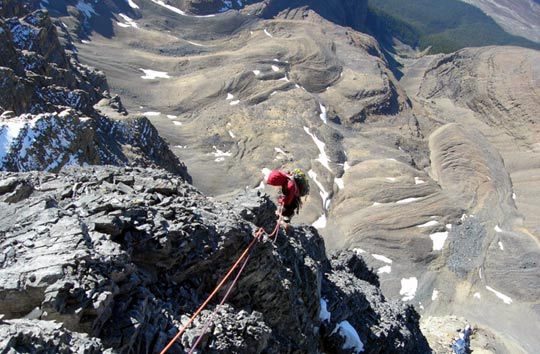
Raphael Slawinski following the first roped pitch on the first ascent of Mt. Alberta’s (3619m) West Face (V 5.10+, 7 pitches, ca. 850m). Slawinski had wanted to ascend the remote, unclimbed face since he saw an image of it in a magazine in 1989. The pair changed into rock shoes at the top of this pitch. [Photo] Eamonn Walsh
Editor’s Note: On September 15, 2007, Raphael Slawinski and Eamonn Walsh made the first ascent of Mt. Alberta’s (3619m) West Face (V 5.10+, 7 pitches, ca. 850m) in the Canadian Rockies. Slawinski recounts the experience in this NewsWire. The ascent is the first of the west face proper; Barry Blanchard and Jim Elzinga climbed the North West Ridge (V 5.9 “A3 and scary”) in 1990. Also see Issue 19’s “In a Push” for a feature on Alberta’s north face.
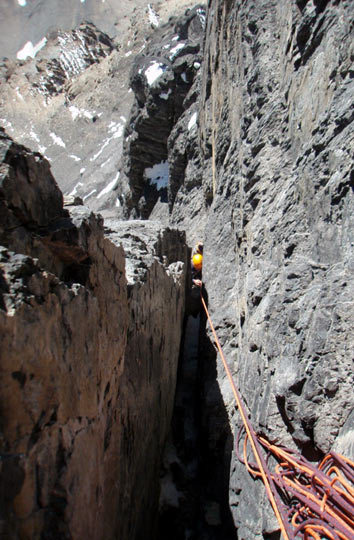
Walsh following Pitch 5, a sustained offwidth/squeeze. Though the rock on this pitch was better than below, Slawinski still managed to score some direct hits as rocks fell down the chimney. The pair speculated that the wide nature of the pitch, the only weakness in the wall, may have helped turn around the Vulgarian attempt in 1963. [Photo] Raphael Slawinski
I love all of the Canadian Rockies, these mighty yet crumbling bastions, and would have a hard time choosing a favorite area, let alone a favorite mountain. Among them are the grey, jagged ridges of Kananaskis Country; Lake Louise with Mount Temple’s brooding north face; the Columbia Icefields and those gashes choked with ice. But if pressed, I would choose Mt. Alberta above all others. I have climbed it in summer and winter, and I have daytripped it from the road and slept on its summit ridge, but I never can get my fill.
In 1989, I first saw a photo of the west face in a magazine. A spectacular aerial shot, it showed a wall of black limestone topped by a dazzlingly white summit ridge, with a rare blue sky overhead. One line in particular jumped out at me: a gothic flying buttress, rising gracefully to the summit icefield. Underneath the photo, the caption read: “The unclimbed west face of Mt. Alberta.” At the time, given my abilities, the photo may as well have been of Olympus Mons on Mars, but I did not forget it. Years passed and I got to know Alberta, or at least the sides of it within easy striking distance of the hut. But the only glimpses I had of the west face were by looking down it from the summit ridge. And from there I could not see much, except that it was steep. This past summer I finally decided to remedy this state of affairs.
On a hot Friday afternoon in late July, Rich Akitt and I hiked over Woolley Shoulder intent on the west face. The next morning, with a full moon lighting our way, we crossed the rubble-strewn glacier toward the south end of Alberta. For a reason that escapes me now, I thought it would be best to traverse one of the large scree ledges that girdle Alberta. The farther we traversed, the narrower and more exposed the ledge became. After much unpleasant sidehilling, and with most of the length of the west face still to go, we turned around and stumbled back to the hut. We lacked the gumption for another attempt, so the following day we ran up the North-East Ridge, descended the Japanese route, hiked out to the road and drove back to Calgary, arriving shortly before dawn on Monday.
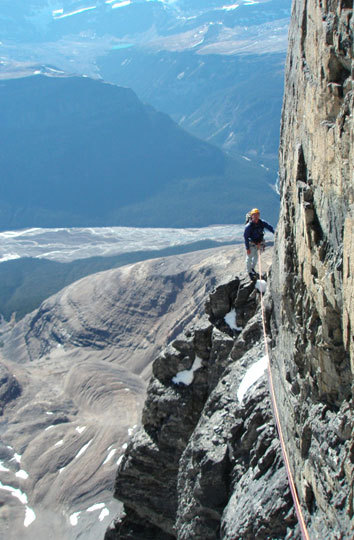
Walsh at the top of Pitch 4, with the Athabasca River nearly two vertical kilometers below. Judging by rappel anchors, this was roughly the highpoint of the Vulgarian attempt. [Photo] Raphael Slawinski
I thought I was done with Alberta for the season, but in mid-September, Eamonn Walsh and I waded across the Sunwapta River and headed up Woolley Creek. The sun was still warm but there was a chill in the air telling of the coming fall. The fresh snow plastering the peaks would not melt until spring. But ever the optimist, I figured the steepness and sunny aspect of the west face would mean it would still be in rock-climbing shape.
Once again we skidded down rubble and jumped gritty crevasses toward Alberta, visible only as a hulking black shape against a star-filled sky. The moon was just past new and did not light our way like last time, but unlike last time I knew where to go. Staying low, we rounded the south end of the mountain and easily walked below the west face across a rocky plateau. At a shallow col that plunged into a deep, shadowed valley to the north, we stopped for a quick rest. A cold wind whipped across the saddle and we were soon moving again, scrambling up scree and rock steps toward the vertical headwall capping the west face. We managed to fill up on water where it trickled down an ice gully, keeping a wary eye for falling stones. Where the gully opened up into a snowfield, we donned crampons and traversed to the base of our chosen rib. A beautiful ribbon of ice cascaded down between the main wall and the lower part of the buttress. We were briefly tempted, but eventually the fact that we had only one tool apiece and no screws convinced us to stick to the rock. Besides, we were freezing, and we could see the first rays of sunlight warming the crest.
At the top of the first pitch, we found an old rappel station: heavy, rusted pins stamped “Swiss made” were connected with bleached goldline. In 1963, four Vulgarians had attempted the west face and nearly made it up before being forced down by severe electrical storms. We would be following in their footsteps for most of the day. Changing into rockshoes, we continued upward. The guidebook describes the opening pitches on the headwall of the North-East Ridge as offering “largely unprotected climbing up to 5.10 on delicate, loose ground [with]… poor to non-existent” belays, “a true test of nerve and ability.” The first time I climbed that route a few years earlier, I was simultaneously disappointed and relieved to find that it did not live up to its “spooky” billing. But the west face amply made up for that disappointment. Crimping on crumbling edges, the last knifeblade a distant memory, I basked in fear.
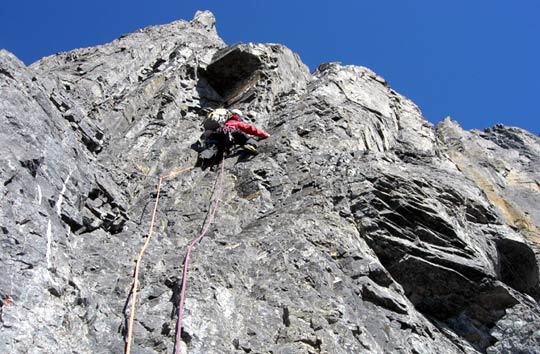
Slawinski about to engage the delicate 5.10 climbing on Pitch 3. [Photo] Eamonn Walsh
As the afternoon wore on and the sunlight turned from white to gold, we were ready to top out, but a steep offwidth crack, the only weakness in what looked to be the final steep step, stood between us and the summit. Fortunately the rock also took a turn for the better, and after some grunting and a few volleys of stones that blasted Eamonn’s head, we were up to the final steep step, which we snuck up via an easy gully. The rockshoes and chalk bags went into the packs, out came boots and crampons. Under an intensely blue sky, more Karakorum than Canadian Rockies, we walked up the gentle snow slope to the summit and, without stopping, headed down the long south ridge.
Night fell just as we completed the last rappel down the Japanese gully, below and upwind of the elephants’ asses. But we knew where to go, and so we were spared sitting out a cold night. Plunging into the darkness, we downclimbed rock steps and surfed scree toward the distant comforts of the hut. The following morning we slept in and lingered over breakfast: rare treats for weekend warrior alpinists.
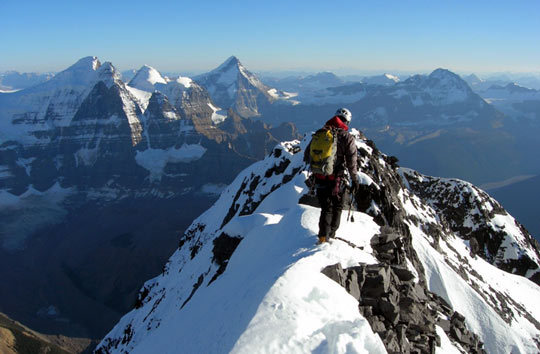
Slawinski descends the Japanese Route from the summit. North Twin and Mt. Columbia are in the background. [Photo] Eamonn Walsh